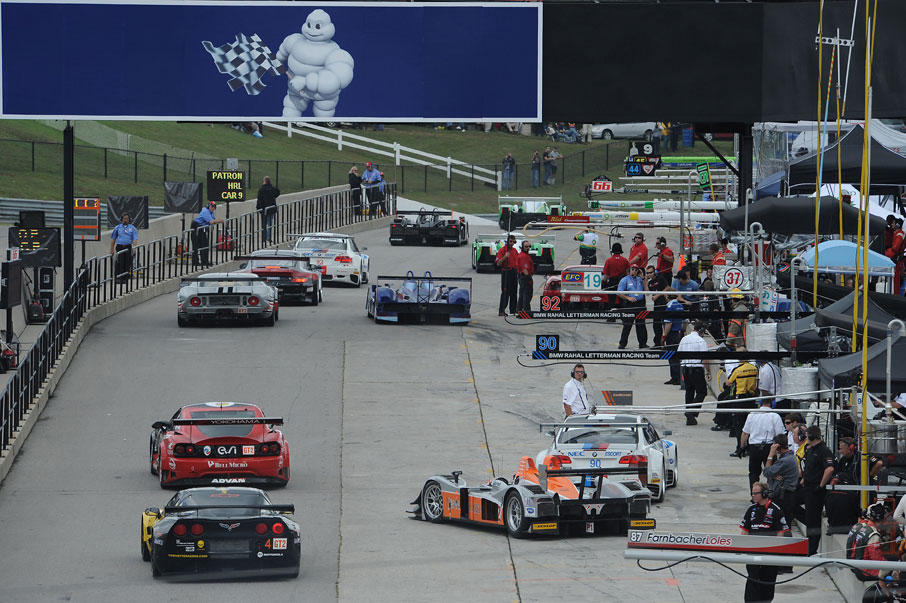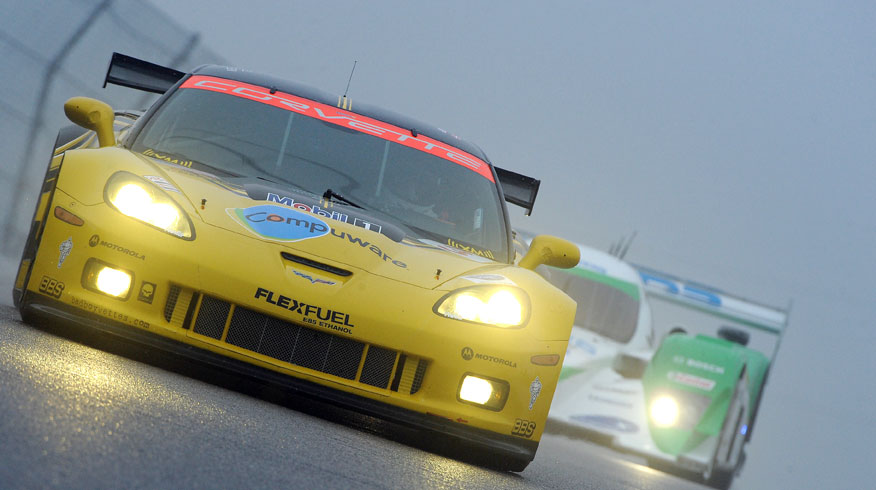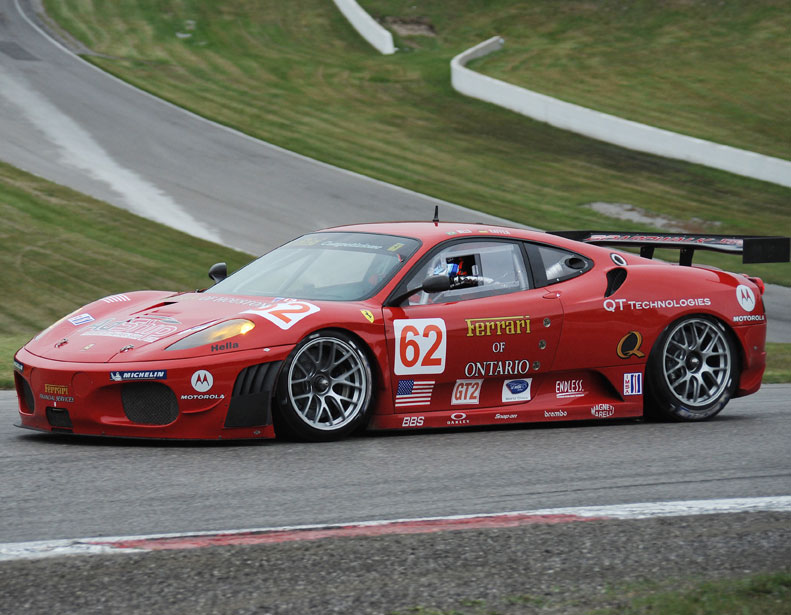Till’s take on Mosport
 |
 |
 |
With the season winding down and only three races to go, the challenges still remain aplenty for competitors in the American Le Mans Series. And there is no greater challenge the competitors will face than the daunting high-speed corners of Mosport International Raceway, the site for Round 8 of the 2009 championship.
It’s hard to sum up all the challenges here and come up with only a small list of words to describe them…how about daunting, intimidating, flowing, wicked and at times downright frightening? If you want to know why all of those words apply, try this: 10 turns, more than 3.5 Gs of lateral cornering loads multiple times, top speeds approaching 180 mph and cornering speeds in excess of 150 mph. If you want fast, this is the place. In fact, Mosport is the fastest track on the American Le Mans Series schedule.
On to the front straight it’s third gear but the challenge definitely arrives at Turn 1. If everything is right take a deep breath, hold on and turn in…flat out. Some prototype drivers are even grabbing the next gear at the apex. Slightly downhill at turn-in, through a rough apex section and let the car track out. There is no chance to rest now because one of the most challenging corners in North America now awaits just a few hundred feet down track.
In years past, Turn 2 has occasionally been flat out as well, and in fact this year based upon some in-car camera laps, it appears that a select few have indeed found their way through without a lift off the throttle. Incredible is the only word to describe it. The entry is blind and slightly uphill. GT cars will sometimes use a double apex here but it seems that prototypes are staying slightly off the first apex at the top of the hill and relying solely on a late single apex. Either way, the driver needs to pick up some type of reference point on the way in to the corner because it is completely blind at entry. My colleague Dorsey Schroeder would aim at the top of a telephone pole just over the top of the hill to direct his approach. Other drivers use patches or telltale stripes on the track. Whatever the reference, it needs to be consistent; after committing to the entry here, there is no second chance. From just past entry to the exit, the track falls away like a roller coaster.
Next up, Turn 3. While certainly not as daunting as many of the other high-speed corners on the track, this corner certainly has its challenges. It is a long duration, late apex right-hand corner with a slight uphill entrance and then off camber at the exit. Prototypes will shift down at least one gear, if not two, for this corner and focus on a smooth entry and good exit. Keeping the car on track and the traction control intrusion at a minimum is important at the exit.
Accelerating away and up two more gears takes the driver to Turn 4 – another flat-out, high-speed, high G-load corner, this time with a hard braking zone just past the apex. This is not the most difficult of the high-speed corners but perhaps the most important point here is a stable car will allow the driver to begin to transition off the throttle and into the brakes while the chassis still has cornering loads in it. From one of the fastest corners on the track into the slowest cornering segment, the transition needs to happen near effortlessly.
It’s heavy braking and down two gears for the initial turn-in at the entry to Turns 5A and 5B, also known as Moss Corner. The braking zone is steeply uphill allowing the car to decelerate rapidly but the track then levels very quickly just past the first apex. Try to push too hard into the braking zone and carry too much speed past that apex and the car will get light at the top of the elevation change and quickly drift too far to drivers’ left, over the track out curbing and off the course. It’s a very fine line on the way in; brake too early and you’re slow; brake too late and you’re dropping wheels at the exit and more than likely ruining the entry into 5B. The slowest corner on the race track (5B) is also one of the most important corners here as it leads on to the longest straight. One more downshift to second on the way in and the focus is on smooth throttle application. A good exit pays dividends all the way to Turn 8 but mess up here and the price to be paid will last for what seems like an eternity.
Even the longest straight at Mosport (the Mario Andretti Straightaway) has plenty of character. A narrow section through bends known as Turn 6 & 7 makes battling with a class competitor while overtaking slower traffic a challenge. And the driver has plenty of time to think about what awaits at the far end – Turn 8.
The top speed of Le Mans Prototypes will approach 180 mph at the end of Mosport’s longest straight and if the car is balanced, the track conditions are ripe and traffic has cooperated, the entry here may just be flat to the apex. But it should also be noted that you can’t see the entry until the last moment. There is a legendary rise at the end of the straight that has wreaked havoc on man and machine in the past. Cars would get airborne as they crested the rise just before the corner entry and because of this, the hill was eventually ground down a bit. But even now, if the frost heave has been severe over the winter or the aerodynamics of the car are a bit off, taking flight is still a real possibility.
Just ask Andy Wallace. Several years ago during a test with Dyson Racing, Andy got airborne at the end of the straight and while the following crash was severe, he walked away without a scratch. The crash was a testament to not only the strength and integrity of modern American Le Mans Series machines but also to the fact that Mosport still has plenty of bite left.
It’s almost time to catch your breath as the last two corners here are relatively straight forward. Turns 9 & 10 are a left/right combination that will take you back to the start/finish line. Braking from the apex of Turn 8 and downshifting at least twice, the driver will trail brakes slightly into Turn 9 and depending on the car, hold the car to driver’s left at the exit or let it track toward the middle of the road on the approach to the final corner. It really depends on the transitional characteristics of the car. Another slight touch of the brakes and down one more gear will have the driver ready to complete his/her lap of the fastest circuit in the American Le Mans Series.
Not only is Mosport a challenging circuit for the drivers, but the engineers and crews certainly have plenty of work cut out for them as well whenever the Series visits here. The compressions of Turn 2 and Turn 4 wear on the underside of prototypes and GT cars alike and put severe loads through the suspension. Crews have to stay on top of any wear issues and make sure the car is ready to endure two hours and 45 minutes of punishment. As for the engineers, trying to find a setup that will allow the car to be stiff enough in roll to withstand the high-speed corners and heavy compressions while still offering suspension compliance with some of the weather-induced surface irregularities is challenging. The aerodynamics of the prototypes suggest the lowest ride height possible but the track and its compressions demand the car is high enough off the ground to reduce bottoming as much as possible.
So you see, there is something for everyone when the Series ventures north. And, as in all forms of motorsports, the TEAM is the key to success. That couldn’t be any truer than here.
SPEED broadcaster and former standout road racer Brian Till will share his insight on some of the most critical corners and sections at American Le Mans Series venues throughout the season. Till will serve as the Series' play-by-play host for its SPEED broadcasts.
